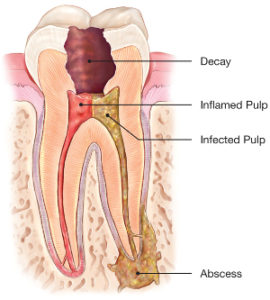Before getting into the specific mechanisms of a root canal in Manchester, it is important to have a basic understanding of the root canal system. Each tooth has a portion above the gumline, known as the crown (clinical crown). Beneath your gums and encased in the bony socket is the root, or roots if a multi-rooted tooth. Inside the root an intricate network of canal system(s). These canals house the dental pulp which contains both the nervous and vasculature systems of the tooth. The nervous system provides sensory feedback in the form of pain when provoked by a stimulus (cold, air, cavities/bacteria, trauma, etc…). The vasculature system provides a conduit to move nutrients, waste products, immune cells, and other key components to keep the tooth ‘alive.’
Now the problem with this system is that this neurovasculature system resides in a structure that cannot expand or contract, unlike a blood vessel. This causes several issues when the pressure changes due to trauma or bacteria causing inflammation of this tissue as it unable to adjust its surroundings to the stresses it experiences. Another problem with this system is that this non-compliant area provides a barrier for bacteria and inflammatory cells to wreak havoc, ultimately causing pain and discomfort.

A normal, healthy dental pulp is referred to as a vital pulp. A vital pulp responds to stimuli with a painful sensation that lasts a few seconds and is comparable to other teeth when subjected to the same stimulus. Take cold for example…cold is natural painful stimulus to the dental pulp. Applying it for a short period of time produces the normal response that lasts for a few seconds and dissipates. However, if the pulp is inflamed, this response will be greatly exaggerated and the painful response to cold will linger for some time.
The difficulty is determining how inflamed the pulp is at any point after a procedure, or cavity develops. The pulp has a tremendous ability to recover from trauma, whether it be from having a cleaning, filling, crown, etc. However, the ability of the pulp to recover from each subsequent insult is reduced…that is with each successive cavity and filling the ability of the pulp to return itself to normal and healthy is weakened. This eventually leads to an irreversible process where the pulp becomes so inflamed that the pressure becomes so great it causes a lot of pain and requires endodontic intervention, in the form of a root canal in Manchester. Success of a root canal procedure when a vital inflamed pulp is treated is extremely high, roughly 94-97% according to most studies.
The question I get most often is: “I have a terrible toothache, but my nerve is dead. How is this possible?!”
When the pressure of an inflamed pulp lasts for sometime without intervention, the pulp can die. The pulp is then referred to as a necrotic pulp. However, unlike the pain caused from an inflamed pulp which is usually confined from within the pulp, a necrotic pulp leads to pain that originates from the membrane surrounding the root called the periodontal ligament. The nerve endings in the periodontal ligament are extremely sensitive and the dead pulpal tissue creates an environment that provides nutrition for the bacteria that have invaded the root canal and caused the necrosis to occur in the first place. Bacterial growth occurs at an exponential rate, and their waste and byproducts accumulate in the confined non-compliant canal, which causes pressure to build. This pressure exists within the periodontal membrane, causing intense inflammation of the nerve endings leading to pain. Commonly patients perceive this pain as coming from within the tooth.
When the bacterial byproducts accumulate they produce puss, which eventually causes destruction of the bone surrounding the root and often the way in which a diagnosis of pulp necrosis is made as it is visible on an x-ray as a dark area surrounding the root tip. The treatment if one wishes to save the tooth is a root canal in Manchester in order to remove the necrotic pulp tissue from the canal space, disinfect the canal space, and seal the canal space with a root filling. Once the dietary source is eliminated the bacteria can no longer survive and the healing process can begin. The healing process when the pulp is necrotic can take several months, sometimes years in medically compromised patients. Overall, the success of root canal therapy on a necrotic pulp ranges from 85-90% according to published literature.

